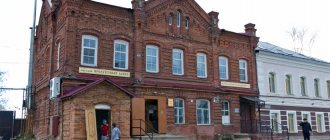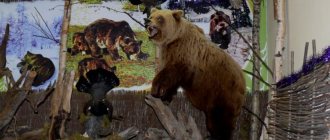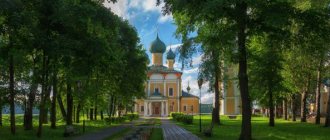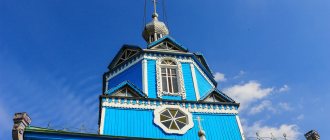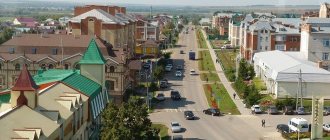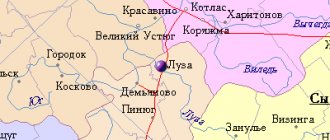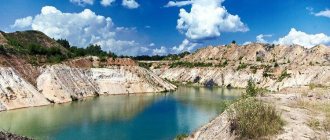Content
- 1 Church of the Resurrection of Christ (Vyatskoye)
- 2 Church of the Annunciation of the Blessed Virgin Mary (Abbakumtsevo)
- 3 Church of St. Nicholas the Wonderworker (Bor)
- 4 Temple of the Smolensk Icon of the Mother of God (Dievo-Gorodishche)
- 5 Peter and Paul Church (Petropavlovskoye)
- 6 Temple of the Savior Not Made by Hands (Rybnitsa)
- 7 Resurrection Church (Burmakino)
- 8 Michael the Archangel Church (Kuvakino)
- 9 Resurrection Church (Levashovo)
- 10 Temple of the Icon of the Mother of God “Quench My Sorrows” (Nekrasovskoye)
- 11 Church of the Nativity of the Virgin Mary (Nekrasovskoye)
- 12 St. Nicholas Church (Netrebovo)
- 13 St. Nicholas Church (Nikolskoe)
- 14 Temple of Paraskeva Friday (Novodashkovo)
- 15 Trinity Church (New)
- 16 Church of the Nativity of the Virgin Mary (Pozdeevskoe)
- 17 Resurrection Church (Black Pond)
- 18 Smolensk Church (Dievo-Gorodishche)
- 19 Tikhvin Church (Timokhino)
Population
| Population | ||||||
| 1959[6] | 1970[7] | 1979[8] | 1989[9] | 2002[10] | 2007[11] | 2009[12] |
| 3039 | ↗4615 | ↗4946 | ↗6950 | ↘6489 | ↘6222 | ↘6193 |
| 2010[13] | 2011[14] | 2012[15] | 2013[16] | 2014[17] | 2015[18] | 2016[1] |
| ↘6154 | ↗6200 | ↘6027 | ↗6063 | ↘6041 | ↘6000 | ↘5904 |
Church of the Resurrection of Christ (Vyatskoye)[edit]
Brick church built in 1750 in the spirit of traditional architecture. A tall five-domed quadrangle with a belt of kokoshniks under the cornice, with an extensive refectory and a very slender pillar-shaped hipped bell tower. The decor is in the spirit of the 17th century. In the refectory are the chapels of Michael the Archangel and Gregory the Theologian. It didn't close.
Vyatskoye was one of the largest and richest villages in the northeastern part of the Yaroslavl province, with interestingly well-preserved stone buildings of the 19th century.
Address:
Russia, Yaroslavl region, Nekrasovsky district, Vyatskoye village, Davydkovskaya street
Telephone
: 8 48531 644 73
Church of the Annunciation of the Blessed Virgin Mary (Abbakumtsevo)[edit]
Church of the Annunciation of the Blessed Virgin Mary
- temple of the Yaroslavl diocese of the Russian Orthodox Church.
The Annunciation Church is the main architectural structure of the village of Abakumtseva. This stone temple was built in 1791 on the eastern outskirts of the village in the style of early classicism. To the chapel of Peter and Paul, which was in the wooden church, another chapel was added - the Archangel Michael. The interior of the Annunciation Church is decorated with oil wall paintings made in 1845, a three-tiered iconostasis with gilded carvings on a white background in the late Baroque style, and a floor made of cast iron slabs. The church had a library that was used by church parishioners.
Address
: Russia, Yaroslavl region, Nekrasovsky district, Abbakumtsevo village.
Telephone:
+7 (48531) 35 35 86
Temple of the Smolensk Icon of the Mother of God (Dievo-Gorodishche)[edit]
The Church of the Smolensk Icon of the Mother of God “Hodegetria” in the village of Dievo-Gorodishche was built in the 1860-1880s on the site of an old brick building.
The main volume was built in 1877-1884, but is designed in the spirit of traditional architecture. A two-story, five-domed quadrangle with an extended refectory and a multi-tiered bell tower.
During the Soviet years, the temple was not closed.
Address
: Russia, Yaroslavl region, Nekrasovsky district, village of Dievo-Gorodishche
Telephone:
+7 (48531) 356 38
Economy
The main enterprises of the village: a machine-building plant (produces technological equipment and spare parts for the food industry), a roofing materials plant, the Nekrasovskaya Confectionery Factory (formerly a dairy plant), and the Nekrasovskaya Sewing Factory.
Nekrasovskoye is a famous resort based on deposits of healing mineral water (there are sanatoriums and a SPA hotel, the most famous are the Malye Soli Sanatorium (www.msoli.ru), the Bolshie Soli Medical Rehabilitation Center[4][5]).
Peter and Paul Church (Petropavlovskoe)[edit]
Peter and Paul Church
in the village of Ptrovskoye is a brick church built in 1802. A two-height quadrangle, completed with a five-domed structure, with an extensive four-pillar, two-height refectory, expanded at the end. XIX - early XX centuries and a four-tiered bell tower. The chapels of Vvedensky and Tikhon of Amafuntsky. Closed no earlier than the late 1930s.
In 1992 it was returned to believers and is being restored.
Address
: Russia, Yaroslavl region, Nekrasovsky district, Petropavlovskoye village
Telephone:
+7 (905) 634 91 36
Temple of the Savior Not Made by Hands (Rybnitsa)[edit]
Temple of the Savior Not Made by Hands
in the village of Rybnitsa - a brick church, built in 1789-1791 at the expense of the peasant K. M. Kuskov and others in the spirit of traditional architecture. A five-domed quadrangle with a two-aisle refectory and a multi-tiered bell tower in the style of classicism. Chapels in the refectory of Nikolsky and Kirill Novoezersky. Closed in 1961. Returned to believers in 1993, slowly being renovated.
Address
: Russia, Yaroslavl region, Nekrasovsky district, village of Rybnitsy
Telephone:
+7(905) 634 91 36
Michael the Archangel Church (Kuvakino)[edit]
Michael the Archangel Church
The village of Kuvakino belongs to the Yaroslavl Metropolis, Yaroslavl Diocese, Nekrasovsky Deanery District of the Russian Orthodox Church.
A brick church with decoration in the spirit of traditional architecture, built in 1777. A two-story, five-domed quadrangle with a semicircular altar, a small refectory and a pillar-shaped hipped bell tower. The refectory housed the Nikolsky chapel. Closed in 1936, abandoned by the 1990s. Restored since 2002.
Address
: Russia, Yaroslavl region, Nekrasovsky district, Kuvakino village
Resurrection Church (Levashovo)[edit]
Resurrection Church
The village of Levashovo belongs to the Yaroslavl Metropolis, Yaroslavl Diocese, Nekrasovsky Deanery District.
It is quite rare for its era, a two-foot, five-domed and tripartite, brick temple of considerable size, with a tiered, characteristically baroque bell tower. In the 17th century, temples of this type were found in the North and Kostroma region, and in the 18th century they became a unique phenomenon. The monument is an outstanding work of church architecture of the 18th century, making a great contribution to the history of Russian architecture
Address
: Russia, Yaroslavl region, Nekrasovsky district, st. Postal
Telephone:
8 910 822 33 16
An excerpt characterizing Nekrasovskoye
“You know that I really think that she is un petit peu amoureuse du jeune homme.” [a little in love with a young man.] - Fine! Fine! Fine! – But how can you say this in Russian?.. When Pierre returned home, he was given two posters by Rastopchin that had been brought that day. The first said that the rumor that Count Rostopchin was prohibited from leaving Moscow was unfair and that, on the contrary, Count Rostopchin was glad that ladies and merchant wives were leaving Moscow. “Less fear, less news,” the poster said, “but I answer with my life that there will be no villain in Moscow.” These words clearly showed Pierre for the first time that the French would be in Moscow. The second poster said that our main apartment was in Vyazma, that Count Wittschstein defeated the French, but that since many residents want to arm themselves, there are weapons prepared for them in the arsenal: sabers, pistols, guns, which residents can get at a cheap price. The tone of the posters was no longer as playful as in Chigirin’s previous conversations. Pierre thought about these posters. Obviously, that terrible thundercloud, which he called upon with all the strength of his soul and which at the same time aroused involuntary horror in him - obviously this cloud was approaching. “Should I enlist in the military and go to the army or wait? – Pierre asked himself this question for the hundredth time. He took a deck of cards lying on his table and began to play solitaire. “If this solitaire comes out,” he said to himself, mixing the deck, holding it in his hand and looking up, “if it comes out, it means... what does it mean?” He didn’t have time to decide what it meant when a voice was heard behind the office door the eldest princess asking if she could come in. “Then it will mean that I have to go to the army,” Pierre finished to himself. “Come in, come in,” he added, turning to the prince. (One eldest princess, with a long waist and a petrified face, continued to live in Pierre’s house; the two younger ones got married.) “Forgive me, mon cousin, for coming to you,” she said in a reproachfully excited voice. - After all, we finally need to decide on something! What will it be? Everyone has left Moscow, and the people are rioting. Why are we staying? “On the contrary, everything seems to be fine, ma cousine,” said Pierre with that habit of playfulness that Pierre, who always embarrassedly endured his role as a benefactor in front of the princess, acquired for himself in relation to her. - Yes, it’s good... good well-being! Today Varvara Ivanovna told me how different our troops are. You can certainly attribute it to honor. And the people have completely rebelled, they stop listening; My girl started being rude too. Soon they will start beating us too. You can't walk on the streets. And most importantly, the French will be here tomorrow, what can we expect! “I ask one thing, mon cousin,” said the princess, “order me to be taken to St. Petersburg: whatever I am, I cannot live under Bonaparte’s rule.” - Come on, ma cousine, where do you get your information from? On the contrary... - I will not submit to your Napoleon. Others do whatever they want... If you don’t want to do it... - Yes, I will do it, I’ll order it now. The princess was apparently annoyed that there was no one to be angry with. She sat down on a chair, whispering something. “But this is being conveyed to you incorrectly,” said Pierre. “Everything is quiet in the city, and there is no danger.” I was reading just now...” Pierre showed the princess the posters. – The Count writes that he answers with his life that the enemy will not be in Moscow. “Oh, this count of yours,” the princess spoke angrily, “is a hypocrite, a villain who himself incited the people to rebel.” Wasn’t he the one who wrote in those stupid posters that whoever he was, drag him by the crest to the exit (and how stupid)! Whoever takes it, he says, will have honor and glory. So I was quite happy. Varvara Ivanovna said that her people almost killed her because she spoke French... “But it’s so... You take everything to heart,” said Pierre and began to play solitaire. Despite the fact that the solitaire had worked out, Pierre did not go to the army, but remained in empty Moscow, still in the same anxiety, indecision, in fear and at the same time in joy, expecting something terrible. The next day, the princess left in the evening, and his chief manager came to Pierre with the news that the money he required to outfit the regiment could not be obtained unless one estate was sold. The general manager generally represented to Pierre that all these undertakings of the regiment were supposed to ruin him. Pierre had difficulty hiding his smile as he listened to the manager’s words. “Well, sell it,” he said. - What can I do, I can’t refuse now! The worse the state of affairs, and especially his affairs, was, the more pleasant it was for Pierre, the more obvious it was that the catastrophe he was waiting for was approaching. Almost none of Pierre's acquaintances were in the city. Julie left, Princess Marya left. Of the close acquaintances, only the Rostovs remained; but Pierre did not go to them. On this day, Pierre, in order to have fun, went to the village of Vorontsovo to see a large balloon that was being built by Leppich to destroy the enemy, and a test balloon that was supposed to be launched tomorrow. This ball was not ready yet; but, as Pierre learned, it was built at the request of the sovereign. The Emperor wrote to Count Rastopchin the following about this ball: “Aussitot que Leppich sera pret, composez lui un equipage pour sa nacelle d'hommes surs et intelligents et depechez un courrier au general Koutousoff pour l'en prevenir. Je l'ai instruit de la chose. Recommandez, je vous prie, a Leppich d'etre bien attentif sur l'endroit ou il descendra la premiere fois, pour ne pas se tromper et ne pas tomber dans les mains de l'ennemi. “Il est indispensable qu’il combine ses mouvements avec le general en chef.”
Temple of the Icon of the Mother of God “Quench My Sorrows” (Nekrasovskoye)[edit]
The Church of the Icon of the Mother of God “Quiet My Sorrows” was built in 1839-1844 at the expense of parishioners and priest I.A. Nazansky.
In 1843, the temple was painted by Bolshesolsk artists E. Sorokin and I. Shvarev. The three-tier iconostasis was made in the 1840s by Moscow craftsmen. The temple icon “Assuage My Sorrows” was painted by the artist N. Bazhenov.
The temple did not close during the Soviet years.
Address
: Russia, Yaroslavl region, Nekrasovsky district, Nekrasovskoye village
Print version
MBUK Nekrasovsky District Museum of Local Lore
Address: Yaroslavl region, Nekrasovsky district,
p. Nekrasovskoe, st. Sovetskaya, 69
Tel.: (48531) 4-36-48, 4-38-75 https://www.nkrmuzey.ru/
In the very center of the village of Nekrasovskoye, in its historical part, a two-story wooden house has stood for more than a century. Initially, a merchant family lived in this house, and when the merchants as a class fell into oblivion, various organizations and institutions were located here. And this went on for several decades. In April 2002, a new life began for this house; the Nekrasovsky Regional Museum of Local Lore opened here. The former living rooms of the merchant house housed museum exhibitions: “Great Salt”, “Peasant Life”, “Tea Room”, “Golden Room” - all these rooms are included in a single composition and excursion. The museum hosts a number of interactive programs: - “We treat you to Russian tea”, “It’s bad for those who have an empty house”, “Madame Maslenitsa”, “Living Antiquity”, “The Road to the Temple” and much more. Various exhibitions are regularly opened in the exhibition halls of the museum.
CHUK Landscape Museum - Saltworks "Salt the Great"
Address: Yaroslavl region, Nekrasovsky district,
p. Nekrasovskoe, st. Cooperative building 1a
Tel.: 8(920)117-34-08, https://ostrov-soli.ru/muzej/
The only landscape saltworks museum in Russia on Salt Island offers you to plunge into the atmosphere of the 17th century and learn the ancient history of salt digestion. Presented to your attention is the reconstruction of one of the 19 Velikosolskaya Varnitsa of the 17th century - “Doroguzha” (salt well, Varnitsa, barn, upper room). Museum of salt shakers, theatrical play programs.
Museum of Romanov Folk Craftsmen
Address: 152260 Yaroslavl region, Nekrasovskoye village,
st. Komsomolskaya, 1b
Tel.: 8(48531)4-14-43, e-mail: [email protected] , 7 kotov @ mail . ru
The Romanov family are hereditary masters of folk arts and crafts, sculptors, and artists. Their clay works are distinguished by their unusual plasticity, amazing liveliness, originality of paintings and brightness of colors. Guests of the home museum will be able to take part in master classes on working with clay and birch bark.
Museum of the "Rural Worker"
Address: Yaroslavl region, Nekrasovsky district,
Alferovo village
Tel.: 8-910-975-31-46, https://petrsovtan.wix.com/agroysadba
The Rural Worker Museum is located in the village of Alferovo, 2.5 km from the regional center of Nekrasovskoye. Here is an exhibition of objects from the work and life of villagers and villagers.
Museum of Russian Entrepreneurship or “The History of a Village That Wanted to Become a City”
Address: Yaroslavl region, Nekrasovsky district,
With. Vyatskoe;
Tel.: (48531) 6-44-87, 8-961-160-81-17,
8-929-077-83-75, https://vyatskoe-selo.rf/
The original beauty of the Vyatka residents is clearly revealed in the Museum of Russian Entrepreneurship. Peasants who went to work in Moscow and St. Petersburg returned to their small homeland as craftsmen: this is how a village grew up in the province, so similar to a city. Details and details of the life of the Yaroslavl village, leading crafts and trades, structure and philosophy of life - the halls of the rural museum tell about this.
Museum "House of Angels"
Address: Yaroslavl region, Nekrasovsky district, village. Vyatskoe;
Tel.: (48531) 6-44-87, 8-961-160-81-17, 8-929-077-83-75,
https://vyatskoe-selo.rf/
The museum is dedicated to the feat of the Vyatka peasant otkhodnik Pyotr Telushkin, who in 1829, without scaffolding, using his own system, repaired the angel wing of the spire of the Peter and Paul Fortress in St. Petersburg.
In the museum you will learn about what angels are and what they mean to people.
The exhibition is not only beautiful and festive, but also deep in its content: here contemplation turns into the comprehension of new truths. Unusual effects create the impression of heavenly existence.
Interactive museum “Rooms of the merchants Urlov brothers”
Address: Yaroslavl region, Nekrasovsky district,
With. Vyatskoe;
Tel.: (48531) 6-44-87, 8-961-160-81-17,
8-929-077-83-75, https://vyatskoe-selo.rf/
The museum tells about what hotel rooms were like in Vyatskoye at the end of the 19th and beginning of the 20th centuries - at that time there were two merchant hotels and three inns in the village.
Kitchen Machinery Museum
Address: Yaroslavl region, Nekrasovsky district, village. Vyatskoe;
Tel.: (48531) 6-44-87, 8-961-160-81-17,
8-929-077-83-75, https://vyatskoe-selo.rf/
The Kitchen Machinery Museum is located on Pervomaiskaya Street and is located in six halls on the first floor of an ancient two-story building.
The museum's exposition introduces visitors to centuries-old established kitchen life.
Children's World Museum (dolls and toys of the Soviet period from 1920 to 1990)
Address: Yaroslavl region, Nekrasovsky district,
With. Vyatskoe;
Tel.: (48531) 6-44-87, 8-961-160-81-17, 8-929-077-83-75
https://vyatskoe-selo.rf/
The museum was created on the basis of the largest collection of children's toys in Russia.
The entire collection is over 2500 items. The museum displays vintage toys of the USSR from different periods, shows all the centers for the production of dolls, and there is a story about the leading sculptors in this area.
The exhibition is interesting not only for children, but also for adults. The museum's motto: “Here every adult will find his own toy.”
Museum of the Vyatka Trading Peasant
Address: Yaroslavl region, Nekrasovsky district, village. Vyatskoe;
Tel.: (48531) 6-44-87, 8-961-160-81-17,
8-929-077-83-75, https://vyatskoe-selo.rf/
One of the main attractions of the historical and cultural complex is the museum of the “Vyatka Trading Peasant” or, as it is also called, “the house of the peasant Gorokhov”.
This museum reveals the features of the difficult life of ordinary people of the 19th and 20th centuries. The museum is imbued with the spirit of the Russian people and clearly shows the life of those times.
Museum "Black Bath"
Address: Yaroslavl region, Nekrasovsky district,
With. Vyatskoe;
Tel.: (48531) 6-44-87, 8-961-160-81-17, 8-929-077-83-75, https://vyatskoe-selo.rf/
In Vyatskoye the museum is housed in a bathhouse preserved from the 19th century on the banks of the Ukhtomka River. First, you can get acquainted with the traditions of Russian bath culture in a tiny but very interesting museum. And then... if desired - a real bathhouse with a broom and a park - this is not only a healing of the body, but also a real immersion in the world of the Russian bathhouse. The smell of a birch broom, the aroma of steamed oak boards, clouds of steam, ice-cold fruit drink in a ladle and silky body skin!
Polytechnic Museum "The Wonderful World of Mechanisms and Machines"
Address: Yaroslavl region, Nekrasovsky district,
With. Vyatskoe;
Tel.: (48531) 6-44-87, 8-961-160-81-17,
8-929-077-83-75, https://vyatskoe-selo.rf/
The museum's exhibition presents the simplest mechanisms that were actively used in peasant life, including among the peasants of the village of Vyatskoye. Felting machine, straw cutters, looms and other useful things.
In the “Wonderful World of Mechanisms and Machines” museum you can make your own engraving on 19th-century machines with views of the village of Vyatskoye.
Museum of Russian Fun
Address: Yaroslavl region, Nekrasovsky district,
With. Vyatskoe;
Tel.: (48531) 6-44-87, 8-961-160-81-17,
8-929-077-83-75, https://vyatskoe-selo.rf/
In the center of the village of Vyatskoye, among a birch grove, there is the Museum of Russian Fun. This is not just an amusement park made according to ancient drawings - swings, carousels, a Maslenitsa Ferris wheel, but also a place where forgotten fun games and amusements of the Russian people are carefully collected and recreated.
"Museum of the Returned Shrine"
Address: Yaroslavl region, Nekrasovsky district, village. Vyatskoe;
Tel.: (48531) 6-44-87, 8-961-160-81-17,
8-929-077-83-75. https://vyatskoe-selo.rf/
The new, anniversary and most spiritual Vyatsky Museum, a museum of one exhibit - the ancient Gospel of the 18th century, lost during the years of the Revolution, returned to the village.
In the intimate atmosphere of the Museum you can take a close and careful look at the Shrine.
You can look through the Gospel on a special electronic stand.
Museum "Pages of Printing History"
Address: Yaroslavl region, Nekrasovsky district, village. Vyatskoe;
Tel.: (48531) 6-44-87, 8-961-160-81-17,
8-929-077-83-75. https://vyatskoe-selo.rf/
Lithography, etching, engraving, books - a wide variety of printing techniques are presented within the walls of the new Vyatsky museum facility. As in all museums in the village, a visitor to “Pages of the History of Printing” will see ancient mechanisms in working condition, and will even be able to study their work not only visually, but also try to make a print with their own hands.
Branch of the Karabikha Museum-Reserve “Abbakumtsevo-Greshnevo”
Address : Yaroslavl region, Nekrasovsky district, village Greshnevo,
With. Abbakumtsevo
Tel., 43-41-81,
It’s worth coming here if only to simply breathe in the healing atmosphere of these places where Nikolai Nekrasov “breathed so sweetly.”
The “quiet homeland” preserves many interesting sights that are inextricably linked with the name of Nikolai Alekseevich. This is the ancient Church of Peter and Paul on the edge of the village of Abbakumtsevo, whose parishioners were the Nekrasov family. At the altar wall of the temple there is a monument to the grave of the poet’s mother Elena Andreevna Nekrasova, who died in 1841. This is the Abbakumtsevo Zemstvo School (school), built in 1871-1872 at the expense of Nikolai Alekseevich Nekrasov. Until 1978, the school was active; currently it is a branch of the Abbakumtsevo-Greshnevo State Literary and Memorial Museum-Reserve of N.A. Nekrasov “Karabikha”.
Museum "Wonder on the Volga"
Address: Yaroslavl region, Nekrasovsky district,
With. Dievo-Gorodishche;
Tel.: 8 (48531) 35-6-86.
The Miracle on the Volga Museum is located in the ancient village of Dievo-Gorodishche, just 20 km away. from Yaroslavl. In all the old guidebooks to the Yaroslavl province this place is about “a fortified village founded by Ivan Diy.”
The museum's exhibitions tell about the original activities of local artisans (rural artisans) - sewing, quilting, embroidery on fabric; about the production of vital items in everyday life, about ordinary and extraordinary objects, “marvelously” decorated with ornaments and designs.
Branch “House-Museum of the sculptor A.M. Opekushina
Address: Yaroslavl region, Nekrasovsky district, village. Rybnitsa (from the bus station "TC Cosmos" (Zavolzhsky district, Aviator Avenue) to the village of Rybnitsa, on the road to Krasny Profintern)
Tel., 8-962-202-21-82;
e-mail;
Website: yarartmuseum.ru
www.facebook.com/groups/opekushin
Working hours: Friday - Sunday: from 12:00 to 18:00
. A wooden two-story house with a mezzanine, richly decorated with carvings on the outside, built at the beginning of the twentieth century. local steamboat operator Ryabinin, located in the village of Rybnitsa, Nekrasovsky district, Yaroslavl region.
Opekushin’s homeland is a historical and cultural region, an original region in the Yaroslavl region. From here, peasant otkhodniks gathered into artels and went to the city to earn money. And some of them themselves opened sculpture and stucco workshops. It was in these workshops that the stucco decorative decoration of the facades and interiors of palaces, theaters, cathedrals and mansions in Moscow and St. Petersburg was created.
In 1913 the house was purchased by K.M. Opekushin, brother of A.M. Opekushina, for use as a stucco department at the local zemstvo school. In 1915, the stucco department was awarded the title of academician-sculptor A.M. Opekushina. In the early 1920s. The stucco department was closed, and the building housed a comprehensive rural school. In 1942-1945. here is an orphanage for evacuated children from Leningrad and a hospital for the wounded, and after the war until 1988. - collective farm artel for the production of haberdashery goods.
In 1988, the house was transferred to the Yaroslavl Art Museum to create a house-museum of the sculptor A.M. Opekushina. In 2012, the permanent exhibition “The Master’s Stucco Works” was opened.
New music museum “Sounds of Time”
Address: Sovetskaya street, 9. Vyatskoye village
Tel:,
Opening hours: Every day from 10:30-18:00
became the twelfth museum opened in Vyatskoye and the thirteenth as part of the Vyatskoye Historical and Cultural Complex. The Sounds of Time Music Museum presents some of the best European collections of sound recording and sound-producing musical instruments. The pearl of the collection is the organ of the Brugger brothers (the first half of the 19th century), only four of which have survived in Russia: in the Hermitage, the Museum of Musical Instruments named after. Glinka, Polytechnic Museum and Vyatka. It is worth noting that only the Vyatka copy has reached us in fully working condition. Every visitor to the museum can hear the music of the organ, as well as the sound of the unique orchestrion from 1908 - an electrified automatic mechanical instrument adapted to imitate the sound of an orchestra.
No less interesting are other exhibits, each of which is a one-piece product: a music box from the Zimmerman trading house, a children's barrel organ, an organeto, phonolas and pianolas, gramophones and gramophones.
At the opening of the museum, a new exhibit was presented - a Russian barrel organ from 1910. Richly decorated, with three oil paintings inlaid into the body, the Russian barrel organ is a rare specimen: today only a few of them have survived in our country.
Church of the Nativity of the Virgin Mary (Nekrasovskoye)[edit]
The Church of the Nativity of the Virgin Mary was built at the end of the 17th century at the expense of the merchant Melnikov on the site of a dilapidated wooden church. Consecrated in 1700. The temple is a five-domed stone church with a bell tower built by the Bolshesolsk architect Stepan Andreevich Vorotilov (lost in the late 1930s). The temple was painted in 1710-1711. Yaroslavl artists Ignatiev, Fedotov and others (there is a mark on the wall of the temple). AND
The temple was closed in 1937. Used as a warehouse until 1996, returned to believers.
Hieromartyr Alexander Bolshesolsky (Pozdeevsky) served in the church.
Address
: Russia, Yaroslavl region, Nekrasovsky district, Nekrasovskoye village, st. Embankment
Story
First mentioned in 1214 as the village of Sol Velikaya
in connection with the struggle between the Rostov prince Konstantin and the Vladimir prince George for local salt springs.
Later the settlement was known as Bolshiye Soli
. In the 15th - mid-17th centuries, saltworks operated here (at the end of the 16th century there were 19 saltworks). In subsequent years, Big Salts was famous for its woodcarvers and masons.
On February 20, 1934, the Presidium of the All-Russian Central Executive Committee decided to “transfer the administrative center of the Bolshesolsky district from the village of Babayki to the village of Bolshie Soli”[3].
In 1938, the village was renamed Nekrasovskoye in honor of the Russian poet N.A. Nekrasov, who spent his childhood in the Nekrasovsky district. Big Salts called Usolovo are shown in his famous poem “Who Lives Well in Rus'”.
Nekrasovsky has had the status of an urban-type settlement since 1940.
Smolensk Church (Dievo-Gorodishche)[edit]
[[Abstract:: Church of the Nativity
rebuilt in 1877-1884. It has two chapels: the Three Saints and St. Andrew of Crete.
The temple's miraculous icon of the Smolensk Mother of God enjoys special veneration among parishioners.
The temple was built in close proximity to the Volga and is designed primarily for viewing from a medium and long distance. His slender silhouette is clearly drawn against the background of the sky and the endless expanses of the Volga. At the foot of the temple, a brick church fence from the late 19th century with an entrance gate and an ancient rural cemetery have been preserved.
The temple was never closed.
Address
: Russia, Yaroslavl region, Nekrasovsky district, village of Dievo-Gorodishche, 2nd Butyrskaya street
Tikhvin Church (Timokhino)[edit]
Church of the Transfiguration of the Lord
in the village of Timokhino is a brick church, built in 1797 at the expense of the peasant S. N. Zherekhov (Sherekhov). A two-story, five-domed quadrangle with baroque decor, with a refectory and a bell tower. The chapels in the refectory are Mikhail-Arkhangelsk and Varvarinsky.
Closed in 1950, later partially dismantled. To this day, only the quadrangle of the cold temple has survived, now empty.
Address
: Russia, Yaroslavl region, Nekrasovsky district, Timokhino village
Notable residents
- Brendyuchkov, Konstantin Grigorievich - taught at the Nekrasovsky College of Agricultural Mechanization, worked as a design engineer at the Nekrasovsky Machine-Building Plant; later a writer.
- Blokhin, Alexey Alexandrovich - discoverer of Bashkir oil and founder of the city of Ishimbaya.
- Mikhail Pavlovich Smirnov - dean, archpriest of the temple “Quench My Sorrows”; later Archbishop of Arkhangelsk and Kholmogory Leonty.
- Evgraf Semyonovich Sorokin is a Russian artist of the academic direction.
- Angelika Vladimirovna Romanova (artist from the Romanov family of Folk Masters
